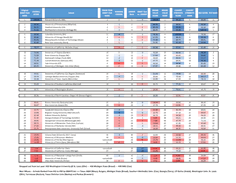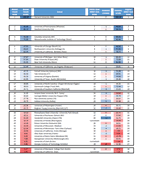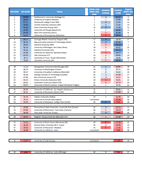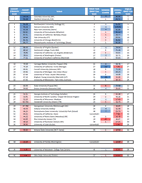GRE Prep Club MBA Rankings 2022May 13, 2021Welcome to the GRE Prep Club’s 2nd Full Time MBA Rankings!Over the last few decades, ranking MBA programs (and other graduate and undergraduate schools) have become more and more popular among applicants. Many publications responded by creating MBA rankings with a spectrum of methodologies and sometimes puzzling data points. Some publications have become so desperate to have a ranking, they have merely averaged other rankings so they might have something to publish!
We have analyzed a number of rankings and dug in deep into drivers. Common issues we found include non-conclusive lists (such as many programs are tied), unexpected (or illogical?) and deviating so far from general perception so as to render them unhelpful (at best) and misleading (at worst). COVID-19 has added another layer of complexity with some schools not participating and rankings algorithms being modified. (US News rankings debacle is a great example of that as we tried to fix them). At the same time, it is always interesting to see data and rankings since they may highlight different elements of MBA programs but rather than have lots of tools that provide partial picture and inefficient comparisons, why not build MBA Rankings that are actually determined based on what matters to the applicants? That’s the challenge we took in the first and this second subsequent release of the GRE Prep Club rankings – Let the people applying actually decide what IS Important (e.g. employment, brand student body strength) vs. what is too theoretical to matter (e.g. number of female professors or peer ranking). Instead, we are focusing on three main components – Brand Value, ROI and Cohort Strength.
| GRE Prep Club's 2022 Full-Time MBA Rankings |
2022
GRE Prep Club
RANK | OVERALL
SCORE | MBA PROGRAM
 | PRIOR YEAR
GRE Prep Club
RANK | RANKING
CHANGE | GRE Prep Club
vs. USNWR | BRAND
VALUE
SCORE | BRAND
VALUE
RANK | COHORT
STRENGTH
SCORE | COHORT
STRENGTH
RANK | ROI
SCORE | ROI
RANK |
| 1 | 100 | Harvard University (MA) | 1 | 0 | -4 | 100 | 1 | 94.12 | 4 | 84 | 11 |
| 2 | 96.04 | University of Pennsylvania (Wharton) | 3 | -1 | 0 | 86.99 | 2 | 89.95 | 6 | 92.26 | 8 |
| 3 | 94.72 | Stanford University (CA) | 2 | +1 | +2 | 85.74 | 3 | 99.98 | 2 | 82.16 | 13 |
| 4 | 91.92 | Northwestern University (Kellogg) (IL) | 5 | -1 | 0 | 66.05 | 7 | 95.28 | 3 | 100 | 1 |
| 5 | 88.46 | Columbia University (NY) | 11 | -6 | -2 | 76.36 | 4 | 100 | 1 | 78.36 | 17 |
| 6 | 86.86 | University of Chicago (Booth) (IL) | 4 | +2 | +3 | 67.03 | 6 | 86.43 | 9 | 95.98 | 6 |
| 7 | 85.46 | Massachusetts Institute of Technology (Sloan) | 8 | -1 | +2 | 75.09 | 5 | 84.77 | 10 | 86.41 | 10 |
| 8 | 82.88 | New York University (Stern) | 7 | +1 | -2 | 55.95 | 11 | 91.18 | 5 | 94.64 | 7 |
| 9 | 78.77 | University of California--Berkeley (Haas) | 6 | +3 | +2 | 63.38 | 8 | 87.41 | 7 | 81.8 | 14 |
| 10 | 74.06 | University of Virginia (Darden) | 10 | 0 | -3 | 43.29 | 15 | 80.43 | 11 | 98 | 2 |
| 11 | 72.09 | Duke University (Fuqua) (NC) | 12 | -1 | -1 | 57.64 | 10 | 60.44 | 23 | 96.65 | 5 |
| 12 | 71.44 | Dartmouth College (Tuck) (NH) | 14 | -2 | +2 | 38.63 | 18 | 80.42 | 12 | 97.17 | 3 |
| 13 | 71.39 | Cornell University (Johnson) (NY) | 16 | -3 | -2 | 47.75 | 13 | 69.91 | 18 | 96.96 | 4 |
| 14 | 69.91 | Yale University (CT) | 9 | +5 | +5 | 45.54 | 14 | 86.96 | 8 | 81.45 | 15 |
| 15 | 69.25 | University of Michigan--Ann Arbor (Ross) | 13 | +2 | +2 | 57.87 | 9 | 69.86 | 19 | 82.39 | 12 |
| 16 | 59.81 | University of California--Los Angeles (Anderson) | 15 | +1 | -2 | 51.44 | 12 | 79.9 | 13 | 60.4 | 26 |
| 17 | 59.78 | Carnegie Mellon University (Tepper) (PA) | 21 | -4 | +1 | 30.6 | 21 | 70.58 | 16 | 89.17 | 9 |
| 18 | 59.48 | University of Texas--Austin (McCombs) | 17 | +1 | 0 | 42.9 | 16 | 67.69 | 20 | 78.72 | 16 |
| 19 | 55.63 | University of Southern California (Marshall) | 19 | 0 | +3 | 35.71 | 19 | 77.21 | 15 | 69.67 | 20 |
| 20 | 50.71 | University of Washington (Foster) | 18 | +2 | -2 | 23.39 | 24 | 79.51 | 14 | 69.7 | 19 |
| 21 | 44.36 | University of North Carolina--Chapel Hill (Kenan-Flagler) | 23 | -2 | +1 | 38.89 | 17 | 52.91 | 26 | 63.67 | 25 |
| 22 | 36.81 | Emory University (Goizueta) (GA) | 22 | 0 | -4 | 14.44 | 30 | 59.83 | 24 | 66.33 | 23 |
| 23 | 36.67 | Rice University (Jones) (TX) | 20 | +3 | -2 | 27.78 | 22 | 42.05 | 34 | 67.95 | 22 |
| 24 | 32.75 | Vanderbilt University (Owen) (TN) | 28 | -4 | +1 | 15.4 | 28 | 50.79 | 28 | 64.61 | 24 |
| 25 | 32.6 | Brigham Young University (Marriott) (UT) | 34 | -9 | -6 | 22.75 | 25 | 67.1 | 21 | 42.97 | 34 |
| 26 | 32.48 | Indiana University (Kelley) | 29 | -3 | +3 | 26.79 | 23 | 46.5 | 30 | 56.33 | 28 |
| 27 | 32.3 | Georgia Institute of Technology (Scheller) | 24 | +3 | -1 | 6.85 | 38 | 54.21 | 25 | 69.3 | 21 |
| 28 | 30.95 | Georgetown University (McDonough) (DC) | 25 | +3 | +7 | 7.68 | 36 | 47.79 | 29 | 71.13 | 18 |
| 29 | 29.72 | University of Minnesota--Twin Cities (Carlson) | 26 | +3 | +1 | 12.04 | 32 | 67.05 | 22 | 47.68 | 32 |
| 30 | 27.65 | University of Rochester (Simon) (NY) | 27 | +3 | -3 | 18.11 | 27 | 40.16 | 35 | 60.31 | 27 |
| 31 | 25.75 | Pennsylvania State University--University Park (Smeal) | 33 | -2 | -2 | 19.33 | 26 | 46.25 | 31 | 49.89 | 31 |
| 32 | 19.94 | Arizona State University (W.P. Carey) | 35 | | +2 | 32.69 | 20 | 33.32 | 37 | 35.42 | 36 |
| 33 | 17.43 | University of Wisconsin--Madison | 30 | | -9 | 12.59 | 31 | 52.25 | 27 | 34.03 | 37 |
| 34 | 14.08 | University of Florida (Warrington) | <unranked> | | +8 | 14.79 | 29 | 15.59 | 38 | 56.22 | 29 |
| 35 | 13.78 | University of Notre Dame (Mendoza) (IN) | 31 | | -1 | 8.28 | 35 | 44.15 | 33 | 37.61 | 35 |
| 36 | 7.56 | University of California--Davis | <unranked> | | -17 | 0 | 40 | 45.21 | 32 | 31.95 | 38 |
| 37 | 7.5 | University of California--Irvine (Merage) | 37 | | -20 | 10.4 | 33 | 70.2 | 17 | 0 | 40 |
| 38 | 3.72 | University of Maryland--College Park (Smith) | 40 | | -4 | 2.37 | 39 | 6.2 | 39 | 54.94 | 30 |
| 39 | 1.32 | University of Utah (Eccles) | <unranked> | | -5 | 6.93 | 37 | 38.95 | 36 | 17.27 | 39 |
| 40 | 0 | Ohio State University (Fisher) | 38 | | +7 | 8.82 | 34 | 0 | 40 | 46 | 33 |
Download Detailed PDF ReportsMethodology: The approach we’ve taken would fall under the analytical umbrella of “we’d rather be generally right than precisely wrong.” We did not curve fit the data; we did not begin with a target slotting for any school; we did not get cute with weightings of sub-scores; we simply tried to take the data that was relevant, available and complete, consider the questions the majority of MBA applicants consider when deciding where to apply and attend, and apply a fresh set of eyes and some new ideas towards analyzing the inputs.
One of the great goals we had for this project (and still have) was to combine US and International rankings into a single table where one could look up how Tuck stacks up against LBS (for example). That goal is still very much alive but for the sake of time (and sanity) we have decided to, for now, focus just on the top US Schools.
Our approach is exclusively based on years of talking to prospective MBA applicants and current MBA students about their priorities in a program and their hopes for their careers after graduation, and being frustrated about the shortcomings of popular MBA ranking methodologies. Most aspiring MBA students state their primary purpose for getting an MBA is to super-charge their career, and they pick their school trying to assess which one is most likely to do that, with the highest probability of success at the lowest possible risk.
Over the last several months, we analyzed hundreds of data points for potential inclusion in our proprietary models. After much thought and consideration, we limited the parameters to only those factors we believe are most intimately related to comparing why a student might prefer one school over another. In the final analysis, even though several might fulfill most (or even all) of their needs and desires and no matter how many great schools are out there, they can still only pick one.
We understand (and embrace) the notion that the best school for you might be different than the best school for someone else; we understand (and embrace) the notion you may place more importance on being close to home or moving to a different country or perhaps seeking a comfortable 70 degrees in February. While important to some, this ranking does not consider any of those factors or whether or not the university’s football program is competitive. As a result, our models did not dedicate any attention to things such as quality of the school building, location of the school, average temperature in February, how many professors have published papers, etc. Those factors may be important to some but we believe they do not ultimately matter to the typical MBA student while they are pursuing (and being pursued by) prospective employers.
We zeroed in three core areas for this ranking (Brand, ROI, Cohort Strength), and have built proprietary models assessing the strength of each of the forty schools in our analysis in each of these three key areas. The strength of each school was assessed in each area, and then these sub-scores were weighted to derive an overall score for each school. The composite scores in each area and the final scores range from 0.0 to 100.0.
Last year, we had a Diversity Ranking we were unable to replicate this year due to a lack of available data. We will consider bringing this back in future years if we are able to access a sufficient amount of relevant data so as to have something meaningful to share. In last year’s ranking, Diversity made up 10% of the aggregate score; for this year, we spread that 10% equally to Brand Value and ROI (raising both from 30% of the overall weighting to 35%).
This is the heart of the rankings; please see more detailed description of each of the four core areas below:
- 35% Brand (i.e., the relative and absolute difficulty to gain admission to any specific program, relative and absolute tendency of applicants to prefer any specific program, and the correlation between the strengths of a program (as perceived by peer institutions) and the preferred areas of study expressed by the typical MBA student)
Last Years’ % Weight to Determine Brand Score
 | This Years’ % Weight to Determine Brand Score
 | Description |
| 66.67% | 50% | Composite score is an algorithm based on three key pieces of raw data, and derivatives and combinations of the same: (i) total number of applicants, (ii) total number of admitted students and (iii) total number of matriculating students in an effort to answer the question: “If a student got into each school they applied to, which one would they be most likely to pick.” We believe our models measure market demand factors and perception factors among other aspiring MBA students. The stronger the market demand for a school, the higher the score. |
| 16.66% | 16.66% | Composite score measuring whether or not Bain and/or Boston Consulting Group and/or McKinsey have determined students admitted to a school are suitable for pre-MBA internship opportunities; the more companies have approved a program, the higher it’s score; this is intended to serve as a rough measure of prestige among prospective employers. |
| 16.66% | 16.66% | Composite score measuring the perception of a programs’ strengths by the administration at other schools as compared to the stated desires of MBA students at all programs measured; the more tightly a schools reputation across its’ departments correlates with the desires of the typical MBA student’s academic interests, the higher the schools’ score. By way of providing an example, most MBA students want to improve their abilities in marketing – so, if a school has a highly regarded marketing department they will score higher than a school with a highly regarded real estate department (since only a small number of MBA students are seeking this specific expertise). |
| - | 16.66% | Composite score constructed identically to the score immediately above – EXCEPT – it only looks at the strength of the four academic areas most demanded by MBA students (in alphabetical order) – Entrepreneurship, Finance, Management and Marketing. A school scoring higher in this area than the one above would have higher perceived strength in these four main areas vs. weaknesses in the other nine less sought out attributes (Accounting, Business Analytics, Information Systems, International, Non-Profit, Production / Operations, Project Management, Supply Chain / Logistics and Real Estate).
To give a sense for why these four areas were selected – they, collectively, represent 62.6% of the total ‘academic areas of interest’ expressed by MBA students (the smallest being Entrepreneurship at 12.5% of the total interest). Of the other nine academic areas combined for 37.4%, and the next closest single area of academic interest was Business Analytics at 6.7% of the demand from MBA students. |
- 35% ROI (1st Year Post-MBA compensation and total program cost (tuition, room, board, books, fees, etc.))
Last Years’ % Weight to Determine ROI Score
 | This Years’ % Weight to Determine ROI Score
 | Description |
| 66.67% | 66.67% | Composite score measuring the published average first year total compensation (signing bonus, salary, other guaranteed bonuses), adjusted downward based on the percentage of the graduating class who does not report their employment details back to the school. Our model is predicated on the belief that graduates who do not report in are either unemployed (but looking for work), unemployed (and no longer looking for work), under-employed (and embarrassed by it), starting their own business (at low initial compensation, and are either embarrassed to report), are working at an unknown start-up (and are potentially embarrassed by the lack of prestige and/or a compensation package they know is lower than others in their cohort). In each instance, these non-reporting students are almost assuredly making less than their peers who did report. Since social norms common among MBA students include a bias against self-reporting below-average information, graduates with low-paying jobs and/or at employers they deem unremarkable are less likely to be reflected in the compensation statistics published by the schools. As a result, in this model, a school reporting higher compensation levels from a higher percentage of their graduating class will score more highly than a school with either lower compensation or a lower percentage of graduates reporting (or both). |
| 16.66% | 16.66% | Composite score which rewards schools who have graduates who (i) have accepted a job prior to graduation, (ii) have accepted a job prior to 90 days after graduation and (iii) have achieved a high level of compensation in the process. The idea is that graduates would prefer to get a great job that pays well as soon as possible, and the longer they have to wait to achieve this goal, the higher the risk they may not actually achieve it – and since achieving a great, high-paying job after graduation is the primary goal of most MBA students, not achieving the primary goal represents a material aspect of whether or not a school is desirable (when compared to others). |
| 16.66% | 16.66% | Composite score reflecting the financial costs to attend a school; tuition, books, room, board, fees, etc. Note that this does not include the opportunity cost of attending other schools, pursuing other degrees, forgoing compensation being earned prior to attending school, etc. A lower cost result in higher score; lower costs reduce the risks a student faces of not achieving a great job prior to (or upon) graduation. |
- 30% Peers (Cohort intellect and experience)
Last Years’ % Weight to Determine ROI Score
 | This Years’ % Weight to Determine ROI Score
 | Description |
| 50% | 50% | Composite score reflecting a schools’ average GMAT score (adjusted based on the percentage of the cohort who has reported their GMAT) and a schools’ average GRE-V and GRE-Q scores (adjusted based on the percentage of the cohort reporting their GRE). In our model, the average GRE scores for all schools reporting their GRE scores were converted to a GMAT equivalent using a widely known and publicly available formula.
NOTE: Six schools did not provide GRE scores (Booth, Columbia, Goizueta, Kellogg, Marriott, and Tuck). To incorporate these six schools into this metric, the lowest GMAT:GRE ratio for all other schools in the tier above, the same tier and the tier below each of these six schools was used to fill in the blank. As a result, we understand that it is possible these six schools may be slightly disadvantaged as a result of their own choice to not publish their GRE scores. |
| 50% | 50% | Composite score reflecting a schools’ average GMAT / GRE score (as discussed above), average GPA, average pre-matriculation work experience, and the relative amount of emphasis a school places on any of those three factors (vs. taking a balanced approach to all three); generally, a school that is consistently above average in each of these three metrics, not favoring one attribute above the others, will score most highly. |
Where is the Data From?The rankings are based on publicly available data such as school websites, class profiles, employment reports, employer sites, and other public data sources. The rankings currently are based on the class of 2022 information. We anticipate updating the results once the class of 2023 data is released by all of the schools (a handful of programs have released their latest class profile but we have to wait until all programs release the data so we have an equitable comparison).
We sought to use a consensus list of top schools. Our list was built after considering those schools positively ranked by other ranking systems, seeking commonality across multiple methodologies. We eliminated outliers (i.e., schools that appeared only once or twice, but weren’t consistently ranked across multiple platforms) in pursuit of consistency. While we believe these forty schools represent the top forty programs in the USA, we understand that others may disagree. Future years may see the list of schools get longer or shorter, and there may be some turnover from year to year.
For frame of reference, US News & World Report (“USNWR”) ranked 143 MBA programs. We eliminated 30 schools from their list due to data sufficiency; none of the eliminated schools were ranked higher than #74. The remaining 113 schools were ranked, and we eliminated schools from the bottom of the ranking until the final 40 schools were left, and are ranked in that order here. NOTE: That had we left all 113 schools in the ranking, there would have been a few changes in the actual schools making the top 40, and the ordering of the schools within the Top 40 would have been altered. Because we believe it’s more relevant to compare the best to the best – which constitute the vast majority of MBA applications submitted across all programs – we have eliminated the smaller and less prestigious programs from our ranking so as to emphasize how top programs compare only to other top programs.
Who Built These Rankings?In the early 1990s,
Regenerate was considering pursuing a full-time MBA. Due to life’s circumstances, he elected to pursue remaining in full-time employment, pursuing other avenues for professional development. In the midst of the chaos of the past few months, he began considering pursuing either an Executive MBA or Online MBA in advance of the second half of his career. After having spent the bulk of the past 25 years in quantitative endeavors, and periodically following the ever-changing ranking systems used by others, he developed strong opinions about shortcomings in the commonly-used rankings. In conjunction with his research into various MBA programs earlier this year, he approached
bb about the subject of rankings, sharing his quarter-century of disappointment in the MBA ranking industry.
As discussed at the outset, BB had been considering a rankings project for many years, and after considering Regenerate’s ideas and perspectives, BB decided to ask him to lead the charge for GRE Prep Club’s inaugural MBA rankings, and then to reprise the effort for this year.
The data compilation, analytical models, and methodology were built by Regenerate, however, BB provided critical feedback and perspective, ensuring the entire project would fulfill the overarching goal – to help the GRE Prep Club’s community members make one of the most momentous decisions they’ll ever make!
Input Welcome!We will continue improving the rankings each year.
We welcome contribution and input in many ways (just hoping they are constructive but it is OK if not 😉). We feel the only way we can strengthen the rankings is by asking the hard questions, continuously innovating, and always thinking.
Originally posted on GMAT Club by Regenerate: https://gmatclub.com/forum/gmat-club-mb ... 57142.html













